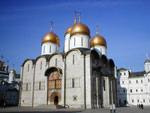 |
| source: mosguides.ru |
The Dormition Cathedral is located in the heart of the Cathedral Square orienting all the other monuments around. This monumental temple is considered the main church of the Russian land. For centuries it was associated with important events in the life of the country. It was there that the Russian tsars were crowned (in 1547 it was tsar Ivan the Terrible, in 1721 - Peter I) and the heads of the Russian Church were elected, the government decrees were announced and prayers were prayed before military campaigns. The metropolitans found their final resting place there too. But before the Dormition Cathedral became so important it had gone through a lot of tribulations.
The history of the Dormtion Cathedral began in the 12th – 13th centuries when the old wooden church was replace by the first Dormition Cathedral by the order of Moscow Prince Daniil Alexandrovich. It existed for about a quarter of a century.
In the 14th century Ivan Kalita decided to rebuild the stone church to make it the most majestic and magnificent in Russia. There was a good reason behind it. In connection with the relocation of Metropolitan Vladimir to Moscow, the capital needed a new temple, which could eclipse the cathedral in Vladimir in beauty and grandeur. In 1470s the restructuring of the Dormition Cathedral began. First, the construction of the cathedral was led by Russian architects but during the erection of arches the church collapsed. The monarch invited new masters - the famous architect from Italy Aristotle Fioravanti and his pupils. Fioravanti finished the construction by 1477. In 1479 the solemn consecration of the Dormtion Cathedral took place. The new Dormition Cathedral reflected the best achievements of ancient Russian architecture and the Italian school. Decorated with five golden domes, the cathedral amazed its contemporaries with its beauty, austerity and grandeur, although quite small. The ceremonial temple still amazes with its harmony and proportionality of all the architectural forms. The Dormition Cathedral in the Kremlin opened a new chapter in the history of Russian architecture. It overshadowed all previously existing Russian churches up to the end of the 17th century and served as a model for imitation, thereby ushering in a whole new era of architecture. The cathedral has three chapels. The main entrance to the temple is located from the side of the cathedral square. The entrance to the building is guarded by the Archangel Michael and the guardian angel. The arches feature the figures of the saints. Above them is the image of the Virgin and Child. These multi-colored murals were painted by unknown Russian artists of the 17th century.
The architecture and the murals of the temple create the image of the cosmos. The arches of the cathedral symbolize the sky supported by the pillars of the cathedral. The interior of the cathedral was created by the best artists of that time. Inside the cathedral is a large ceremonial hall. The unique wall-painting, the icons and variable church plate are considered among the world's priceless works of art. In the Dormition Cathedral there is a magnificent five-tier iconostasis, traditional for Russian churches. Every era left its memorable tracks in the Dormition Cathedral. In 1551, during the reign of Ivan the Terrible, the wood carvers produced and installed in the temple the so-called the “Monomakh place” or the “Monomakh’s Throne”. The throne’s legs are the four carved wooden animals, and the walls of the throne are covered with bas-reliefs depicting the coronation of Vladimir Monomakh in Constantinople. Above the throne stands a carved marquee on the figured columns.
The sacristy of the Dormtion Cathedral keeps a jasper container for precious myrrh intended for the Russian tsars crowning, the so-called Augustan Krabi. This vessel, according to the legend, belonged to the Roman emperor Augustus. From Rome, it got to Byzantium and from there was sent as a gift to the Emperor Alexis Comnenus Vladimir Monomakh. During the war of 1812 the Dormtion Cathedral was devastated by Napoleon's troops; they arranged the stables there. Before their flight from Moscow they carried away for more than five thousand tons of silver and about three hundred kilograms of gold. After the war, the returned silver was used for the central chandelier of the church.
The services in the Dormition Cathedral were resumed in 1990.

